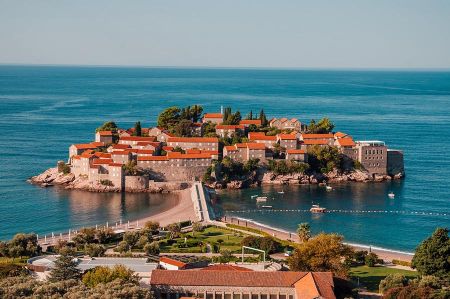From Dubrovnik to Shkodra – stopover in Budva
- Written by Portal Editor
Coming from Dubrovnik, we were traveling with our caravan in the direction of Shkodra to Camping Legjenda, better known to some of our readers as Linda and Franc, and had chosen Budva in Montenegro as our stopover destination.
Not that a stopover was necessary because of the route, it was just about spending some time in the city that is so well known among beach vacationers. The old town of Budva is particularly well known, nestling on the bay and thus the Adriatic coast, which is highly valued by locals and especially Eastern European tourists.
Adventurous journey to the Budva campsite
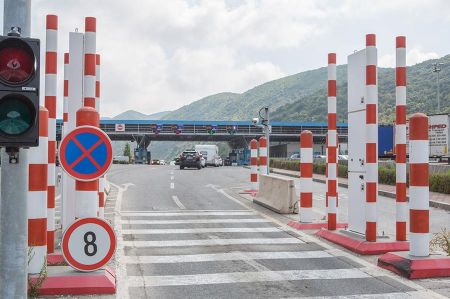 Coming from Dubrovnik, we use the Jadranska Magistrala (E65) towards Ruđer Bošković Airport and further towards the border crossing into Montenegro, where we noticed numerous police checks on the way, and even speed cameras, despite the really very low traffic volume.
Coming from Dubrovnik, we use the Jadranska Magistrala (E65) towards Ruđer Bošković Airport and further towards the border crossing into Montenegro, where we noticed numerous police checks on the way, and even speed cameras, despite the really very low traffic volume.
There was little activity at the border crossing, so the formalities were completed quickly. Interesting for us that the Montenegrin border station only follows a few more kilometres downhill.
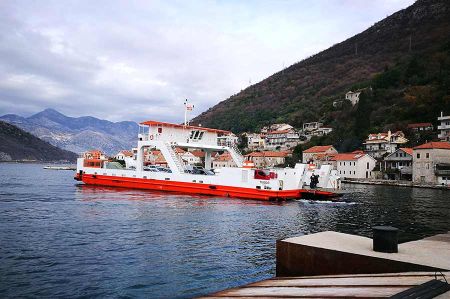 In the town of Igalo we reach the Bay of Kotor on the E65, which goes around the bay as the E80 to the town of Kotor. This time, however, we decided to use the ferry at Kamenari in order to save ourselves the wonderful but very winding tour around the bay, which is an adventure in itself if you go on the ferry as a team.
In the town of Igalo we reach the Bay of Kotor on the E65, which goes around the bay as the E80 to the town of Kotor. This time, however, we decided to use the ferry at Kamenari in order to save ourselves the wonderful but very winding tour around the bay, which is an adventure in itself if you go on the ferry as a team.
As a trailer driver, please always remember not to be the first vehicle to drive onto the ferry on the far right or far left. When driving out, the caravan often swings out further than previously thought. Since there was only moderate activity here, the crossing was completed just a few minutes later.
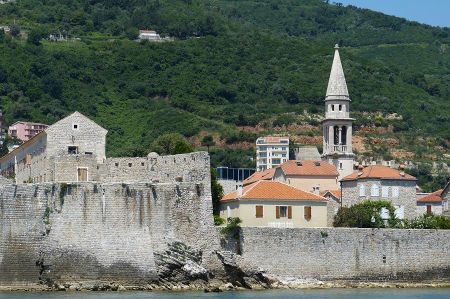 After a few shots we were able to continue our way towards Budva and reached the city a good 90 minutes later. The desired campsite is near the E65 / E80, also called the Adriatic Highway. Once you have crossed the Grdevica river, please keep left into Velji Vinogradi, then immediately left again to Budva campsite (GPS: 42.290152,18.845351).
After a few shots we were able to continue our way towards Budva and reached the city a good 90 minutes later. The desired campsite is near the E65 / E80, also called the Adriatic Highway. Once you have crossed the Grdevica river, please keep left into Velji Vinogradi, then immediately left again to Budva campsite (GPS: 42.290152,18.845351).
Despite the central location in the centre of the very noisy city of Budva, the campsite is absolutely quiet. The space is spacious and the owner is very nice, speaks good English and everything is relaxed. Powered by a power distributor and there is drinking water supply and a renovated toilet and shower.
Since we are there in time, we have the rest of the day to explore Budva.
Walking tour to Budva Old Town
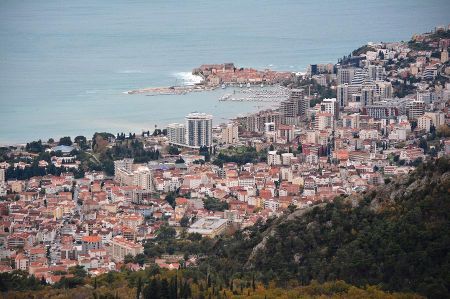 What is particularly famous in Budva is the old town, which is located on the bay and thus the Adriatic coast. The city has developed around the small peninsula on which the old town is located.
What is particularly famous in Budva is the old town, which is located on the bay and thus the Adriatic coast. The city has developed around the small peninsula on which the old town is located.
The historic city centre (Stari grad), surrounded by an old city wall and predominantly built by Venetian buildings, is now connected to the mainland by a sandbank. In earlier times it was located on an island near the coast, but it lost its isolated location due to sediments that washed up.
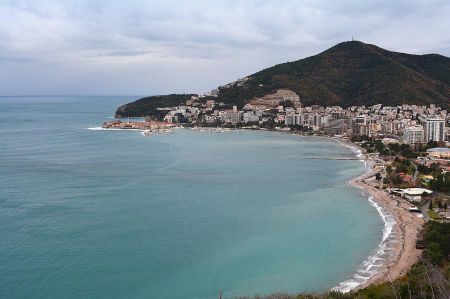 The southeastern town of Sveti Stefan is in a similar coastal situation. The relatively strong sea surf in the region causes a constant displacement of considerable masses of rubble and sand. The Bay of Budva is also bordered by the small island of Sveti Nikola (also known locally as Havaj, derived from Hawaii). It is the largest island in Montenegro and was previously accessible on foot via a headland. Today it is uninhabited except for the lighthouse keeper, but can be reached by boat in summer
The southeastern town of Sveti Stefan is in a similar coastal situation. The relatively strong sea surf in the region causes a constant displacement of considerable masses of rubble and sand. The Bay of Budva is also bordered by the small island of Sveti Nikola (also known locally as Havaj, derived from Hawaii). It is the largest island in Montenegro and was previously accessible on foot via a headland. Today it is uninhabited except for the lighthouse keeper, but can be reached by boat in summer
Due to the earthquake on April 15, 1979, most of the buildings in the old town were damaged or completely destroyed, but were then reconstructed stone by stone in the Venetian style according to plans from Austrian archives.
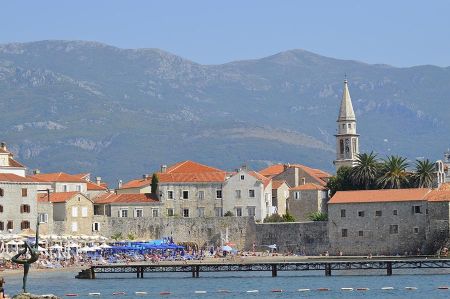 Two of Budva's most important buildings are the three-aisled Church of St. John the Baptist from the 9th century and the Orthodox Church of the Holy Trinity from 1806. Another Orthodox church is located on the grounds of the Podmaine Monastery, which is located on the outskirts of the city.
Two of Budva's most important buildings are the three-aisled Church of St. John the Baptist from the 9th century and the Orthodox Church of the Holy Trinity from 1806. Another Orthodox church is located on the grounds of the Podmaine Monastery, which is located on the outskirts of the city.
To the west of the city, at the foot of Mount Spas, is the Mogren Fortress, built by the Austrians in 1860. The Kosmač Fortress, also built by Austria-Hungary in the 1840s, is located on the road from Budva to Cetinje. It was the southernmost fortress of the once powerful Habsburg Empire. There are also some monasteries with cultural and historical significance.
Continue to Shkodra to Camping Legjenda.
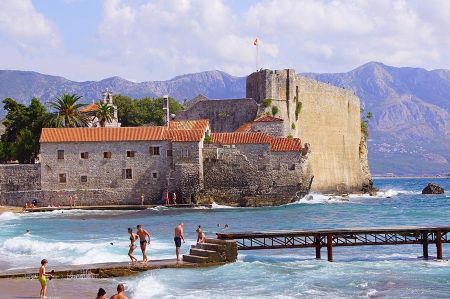 It wasn't until late in the evening that we returned to the campsite, where we had extensive conversations with other travellers. In the course of the discussions, we decide to spend another day in Budva and only after another night to continue the journey to Shkodra, but we want to use the M2.4 along the coast to Ulcinj in order to get to the border with Albania from there. It's only a few kilometres from the border to Camping Legjenda, so we can take our time driving along the coast.
It wasn't until late in the evening that we returned to the campsite, where we had extensive conversations with other travellers. In the course of the discussions, we decide to spend another day in Budva and only after another night to continue the journey to Shkodra, but we want to use the M2.4 along the coast to Ulcinj in order to get to the border with Albania from there. It's only a few kilometres from the border to Camping Legjenda, so we can take our time driving along the coast.
Please also read:
